| Model | Rating | Buy Now |
|---|---|---|
Winegard RVW-395 |
4.7 |
Check Price |
King OA8300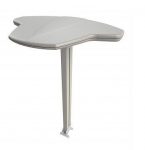 |
4.5 |
Check Price |
Winegard RS-3035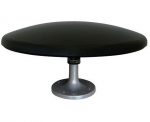 |
4.4 |
Check Price |
Antop UFO AT-416B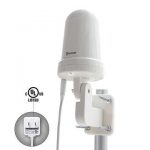 |
3.9 |
Check Price |
1ByOne RV Antenna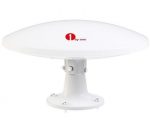 |
2.9 |
Check Price |
Let’s say you are ready for your next RV trip.
Don’t forget entertainment on the road!
It will help you relax, but also stay alert for any service information.
Watch TV in your RV is great when it’s raining outside and you want to relax.
You don’t want static in those moments, don’t you?
Then, you need a good TV antenna.
Here are the best TV antennas for the season.
Winegard RVW-395
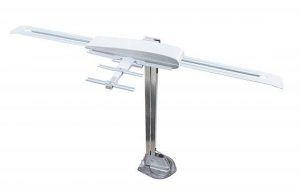
The Winegard RVW-395 antenna is a simple upgrade to every camper, even the older models.
Despite not getting too many accessories with antenna, you can expect reliable signal and excellent performance.
It is an amplified antenna, which means the antenna picks VHF and UHF signals.
The antenna has a 55-mile radius and supports SD and HD channels.
It is easy to mount on the rooftop of your RV.
Pros
- Long-range antenna
- Easy to mount
- Reliable
- Compact and lightweight
Cons
- Pricey
- A bit high profile
- Tuning-in around valleys can be tricky
 Dylan's Take
Dylan's TakeThe Winegard Sensar IV antenna is simple, and it comes with all the necessary cables and hardware for mounting.
It has a decent radius and excellent performance.
King OA8300
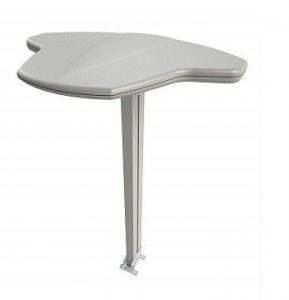
The King antenna offers outstanding value for the money.
It is a sleek and simple antenna that can provide a lot of channels with excellent images.
The price is affordable, and the antenna uses technology to enhance UHF and VHF signal reception.
It comes with universal mounting brackets, so you can easily install it on your RV or use it at home.
Pros
- Budget-friendly
- Easy to set up
- Long-range antenna
- Sleek design
- Strong signal
Cons
- Limited warranty for the parts
- Not omnidirectional
 Dylan's Take
Dylan's TakeKing antenna is budget-friendly, and won’t disappoint you in any way.
Also, the company is reliable and offers great service to its customers.
Winegard RS-3035
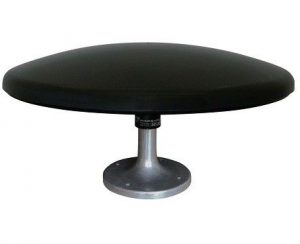
This Winegard antenna is omnidirectional, which means you don’t have to manually turn it in different directions to find a signal.
It also has a 5-year warranty, which is pretty impressive.
The housing has a smart aerodynamic design, which reduces wind resistance.
It results in better signal and lower damage.
The construction is weatherproof and the materials have UV protection..
Also, it captures UHF, VHF, and FM band signals.
Pros
- 5-year warranty
- No manual adjusting
- Long-range signal
Cons
- Expensive
- Complex installment
- Lacks 3G and 4G filter
 Dylan's Take
Dylan's TakeIf you are ready to give more money for a reliable and omnidirectional antenna, I recommend this Winegard one.
The features and the warranty makes it stand apart from similar products on the market.
Antop UFO AT-416B
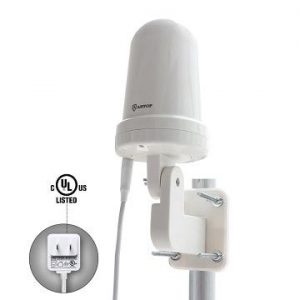
The Antop UFO antenna has a built-in amplifier, which improves the reception of short and long-range signals.
It has a 4G filter, so there is no interference with cellular networks.
The housing is waterproof and UV protected, which improves durability.
It is reasonably priced and relatively easy to install.
Pros
- Lightweight
- Suitable for home use and RV
- Omnidirectional
- Range 30-40 miles
Cons
- May struggle with VHF signals
- Lower rating than similar products
 Dylan's Take
Dylan's TakeAntop UFO antenna has unique features that really improve the user’s experience.
The signal is exceptional and it doesn’t take a lot to install it.
1ByOne RV Antenna
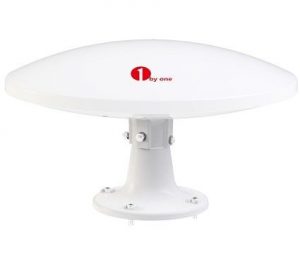
The 1byone antenna has a sturdy mount which improves wind resistance, keeps the signal steady and the antenna protected.
It supports UHF, VHF, and FM signals.
The 1byone RV antenna includes a built-in amplifier which improves the reception and 30 dB gain.
It offers a great balance between features and price point with an outstanding range of 70 miles.
Pros
- 70-miles signal reception
- Omnidirectional
- Tool-free installation
- 1080p HD image
Cons
- Heavy
- Low rating
 Dylan's Take
Dylan's TakeI also like how easy to install this 1byone antenna.
It is an affordable, and reliable antenna despite being last on my list.
Buying Guide
With a good RV TV antenna, you won’t ever miss your favorite TV show.
It will allow you to tap into NBC, FOX, CBC, and ABC broadcast channels.
Antennas go on the rooftop, and modern ones ensure a full HD image.
There are some excellent products on the market, and it is useful to learn more about them to pick the best one for your money.
Let’s break things down about RV TV antennas.
Types
We can divide all TV antennas into two types: HDTV and satellite, indoor or outdoor models.
Let’s go briefly through each one.
HDTV Antenna
HDTV models pull in the local broadcast channel by tapping them into the UHF band.
Their typical range is 50 miles.
The image is better than satellite or cable models because you are receiving a signal from the broadcast tower directly.
The signal is free, so you only have to pay for the antenna.
Other benefits of using an HDTV antenna are excellent quality and exclusivity of some local channels, available only through the antenna.
The drawbacks include limited channels and limited reception in certain areas.
Satellite Dish
Satellite dishes focus on one broadcast source and require a provider who charges a fee for the signal.
The image might not be as clear as with HDTV, because it is compressed.
Still, satellite dish ensures a bigger range of available channels.
Potential drawbacks include signal fading when the weather is bad outside.
Indoor Mounted Antenna
Indoor antenna goes inside your RV and is easy to set, position and control.
You don’t have to drill holes or wait for the weather to clear to install it.
Still, the range of these antennas is of poorer quality because of RV walls.
Sometimes, you have to store it when not use while driving to avoid damage.
Outdoor Mounted Antenna
The roof is the best location for these antennas, but some people mount them on sides or bumpers.
Most commonly, these antennas are made from aluminum and plastic.
The antenna has a decent range, better than indoor models.
It can pick a lot of channels.
Potential drawbacks include lowering the antenna when you are on the road.
They are also more difficult to install and sometimes require drilling holes.
HDTV VS Satellite Antenna
You should choose an antenna based on your needs and preferences.
Determine your priorities first.
Is a budget-friendly antenna with a broad range something for you?
Or, you need a specific channel available only on satellite?
Most people choose HDTV antennas for the price and excellent image quality.
However, if your favorite TV shows are only available on satellite, you know which one is for you.
HDTV Antenna Pros
Broadcasting signal through HDTV antenna is free.
There is not a subscription, and these antennas are much affordable to run.
HDTV antenna gives you access to local programs, which can help you learn more about the area you are traveling through at the moment.
These antennas are also easy to install.
It might require drilling a few holes, fitting parts together, screwing things, and hooking up the coax cable.
Indoor installation only takes basic assembly.
You can also install a signal booster to improve the signal.
Some antennas come with signal amplifiers as well.
Is it Possible to Watch TV While Driving?
In theory, you can watch TV while driving, but it can be pretty difficult.
The reception might be one problem you encounter when driving through the mountains.
An antenna only works by delivering the signal from the broadcast tower.
Therefore, if there is no broadcast tower within the antenna’s range, you won’t have channels.
Sometimes in areas, there is remote access which might improve the signal.
Additional issues with some outdoor antennas are the mountains.
Some need to be taken down while you drive.
If you are driving around trees, a branch may come in the way and damage the antenna.
People who want to watch TV while driving may choose indoor antennas, but it still doesn’t guarantee that you’ll have good reception.
How to Find Local TV Stations?
There is a smartphone app for local TV towers.
Android users may install an app called TV Antenna Helper, while TV Tower U.S.A. is available for iPhone users.
The apps will give you a list of nearby broadcasting towers.
Also, you will learn in which direction to move your antenna to get the best signal.
The old-fashioned approach includes setting the antenna and scanning for channels on TV.
If you aren’t satisfied with the channels, you can turn the antenna and scan again.
Repeat the process until you are happy with the channels.
Features to Look For When Buying an RV Antenna
Some features can improve your experience when using an RV outdoor antenna.
Let’s talk about the best features to look for in an RV antenna!
Range
The range of 25 miles is average, but many antennas on the market have a far better range.
Generally, if you travel into urban areas, you will have enough signal wherever you go.
But, going to distant locations requires better signals.
Keep in mind that antennas with a wider range are pricier.
Type
Go through my section of types to determine whether HDTV or Satellite antenna is the right choice for you.
Installation
Ease of installation is preferable, but it shouldn’t be the determining factor.
It is worth taking extra time to install the antenna if it will give you a better signal.
3G/4G Filter
Buying an antenna with a 3G or 4G filter will ensure noise-free reception.
The filters block the cellular wireless signal and reduce interference.
Mounting an RV Antenna
Indoor antennas are simple, you can put them on a flat surface.
There are also indoor antennas that can be attached to the wall or window with a suction cup.
Outdoor antenna goes on roof, sides, or bumper.
Mounting an RV Antenna on the roof is the best method, as it will ensure full use of outdoor installation in terms of signal reception.
If you own an indoor antenna, place it near the window to improve reception.
Installing an RV Antenna
The installation depends on the antenna model and your chosen location for the mounting.
In most cases, there are several steps to follow.
I’ll go through the steps briefly.
Always check the manufacturer’s instructions before you install an antenna.
Mounting Outdoor Antenna on the Roof
The first thing to do is find the place on the roof where you would put the antenna.
I recommend placing it near the refrigerator vent because of easier cable access.
Drill two straight holes in the roof.
One serves to hold coax cable, and the other is for the antenna.
The holes can be half an inch, but check the instructions for specific measurements.
Clear the insulation from holes and run coax cable through the hole, attach it to the antenna.
Then, slide the driveshaft and check the instructions for further steps.
In most cases, you’ll have to drill more moles to attach a mounting plate, and screw it to the roof.
Lastly, seal the holes off and add weather sealant.
It is an essential step because it will prevent leaks.
Connecting Antenna to TV
The first thing to do is connect the coax cable to the port on your TV.
The port on your TV will probably have a label, such as “antenna in”, and it will look like a cylinder with a hole.
Once you connect the coax cable, turn on the TV.
Scan the channels.
If there are no channels and you are sure that you are in the broadcast tower range, manually adjust the antenna and try again.
Boosting the Signal
Boosting the signal ensures a better picture and improved reception.
You can boost the signal if the picture is grainy or there are no channels.
Here are a few things to do to improve the signal.
Change the Antenna Direction
Sometimes, even moving your antenna for a few inches can make a difference.
The grainy picture often occurs if the antenna isn’t well aligned.
Use the app to see in which direction to move the antenna.
You can also get a signal strength meter to see in which direction the signal is strongest.
Check the Cable
Make sure the coax cable is properly connected, and there is no damage to the cable.
An RG 6-coaxial cable is known for the strongest signal.
Change the Location
If you tried everything, and the signal is still poor, consider moving your RV to another location.
High ground parking picks the best signal, while parking around tall trees and tall buildings can cause signal issues.
Signal Booster
A signal booster can help you improve the signal.
It is a device that connects to an antenna.
Sometimes, RV has a built-in signal booster, but replace it with a newer model.
Don’t forget to turn the device on to make it work.
Turn it off once you are done watching the TV to prevent the battery from draining.
Conclusion
There are so many great options on the market that will give you excellent signals and a variety of channels.
You can choose between HDTV and satellite antennas for the best results.
I recommend Winegard RV antennas, but you can find decent options with a lower price tag.
Have you found your RV antennas? Which one seems like the best fit for your needs?
Best Overall Choice
Winegard RVW-395

We're a team of professional travelers, on-the-go freelancers, web producers, writers and editors. Our mission is to pick the best travel gear by analyzing customer opinions and writing our own findings to help you find the right products for you. Please share our posts to help us grow. Read more...




